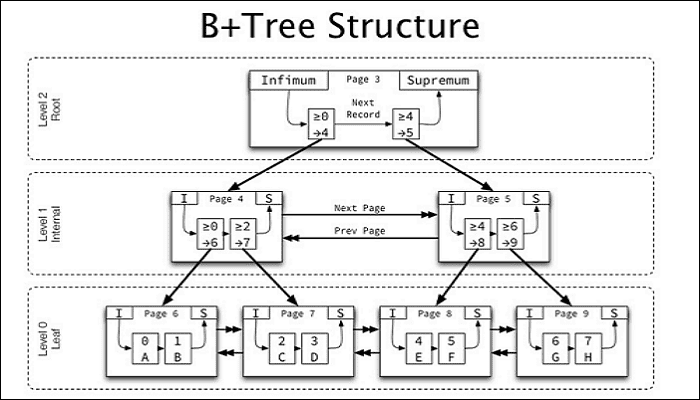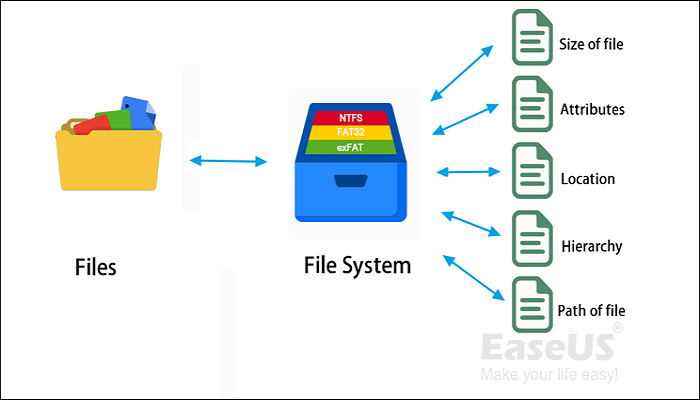In this article, EaseUS elaborates on the difference between the three file system types, ReFS, NTFS, and FAT32. You will know their specific features, pros, and cons by reading this article.
We all know that a file system is a structure in which the operating system can manage data in groups through logical rules. It helps the operating system to manage data and files logically. With its help, users can easily access, read, write, modify, and protect data on their storage devices.
?ReFS VS NTFS VS FAT32: What Are They
Windows 11 is getting ReFS support; NTFS and FAT32 are the most popular file system types. However, what are they? Which one is the best choice? Continue to read:
ReFS:
On 9, 2012, Microsoft launched a new generation of advanced file systems - Resilient File System, also known as ReFS. ReFS is designed based on the NTFS code. Microsoft hopes that it will be more reliable, have the greatest data availability, and meet more data storage needs of users. In addition, ReFS is compatible with Storage Spaces spanning volume technology. Therefore, when the disk reads and writes fail, ReFS will perform a system check, detect these errors, and copy the file correctly. Due to the B+ tree structure, ReFS can help users store more data through branches, which also leads to better storage performance than NTFS. ReFS has a maximum file path of 32,768 characters.

NTFS:
The NTFS file system has been regarded as the default file system format in the Windows operating system after the Win 98 operating system, surpassing the FAT file system in some aspects. For example, it supports metadata, and NTFS disk utilization is higher than FAT32. NTFS-formatted systems can support disk partitions up to 2 TB.
FAT32:
FAT32 is a file system capable of organizing all files stored in a disk drive. 32 refers to the number of bits the file system uses to store addresses, which distinguishes it from its predecessor, FAT 16. FAT32 was created at the beginning of the drive to store every information found in the host computer. FAT32 is a unique disk format. It is worth mentioning that it has good compatibility. Both Windows and Mac can read FAT32.
Well, what's their difference? Which one is the best file system? Which one is your best choice? The next part will answer your questions.
?ReFS VS NTFS VS FAT32: What's Their Difference
Although ReFS, NTFS, and FAT32 are all file systems launched by Microsoft, there are still big differences. The following content will show you the difference in several aspects:
| Comparison | ReFS | NTFS | FAT32 |
|---|---|---|---|
| ✏️Compatibility |
Windows Server 2022/2019/2016/2012 R2 and Windows Server 2012 |
Windows 2000/XP, Windows 2003/Vista/7/8/8.1/10, Windows Server 2008/2008 R2/2012, GNU/Linux, macOS X | All Windows versions, Linux, macOS, Gaming consoles like the Xbox One, PS3/4, and the Steam Deck |
| ✏️Max Volume Size | 35 PB | 8PB | 32GB |
| ✏️Max File Size | 35 PB |
|
4GB |
FAT32 is widely compatible with a lot of devices, which is its main advantage. However, its disadvantages are its size limit and gradually being out of date. You can share this article on your social media to let more people know their differences.
As you can see, NTFS and ReFS are much better than FAT32 in max volume size and max file size, and ReFS is similar to NTFS. Hence, ReFS is a good alternative to NTFS to a certain extent. Now, let's see their similar features from the table below:
| Comparison | ReFS | NTFS |
|---|---|---|
| Data Deduplication | Yes | Yes |
| Cluster Shared Volume (CSV) support | Yes | Yes |
| BitLocker encryption | Yes | Yes |
| Access-control lists | Yes | Yes |
| Soft links | Yes | Yes |
| Trim/Unmap | Yes | Yes |
| Changes notifications | Yes | Yes |
| Thin Provisioning | Yes | Yes |
| Junction points | Yes | Yes |
| USN journal | Yes | Yes |
| File IDs | Yes | Yes |
| Changes notifications | Yes | Yes |
| Mount points | Yes | Yes |
| Volume snapshots | Yes | Yes |
| Sparse files | Yes | Yes |
| Named streams | Yes | Yes |
You May Also Like:
However, is ReFS going to replace NTFS? The answer is, of course, No. They are so similar and different at the same time. Let's see the pros and cons of NTFS and ReFS:
Pros of ReFS:
?Resiliency: ReFS has built-in resiliency, which checks files as you read or write them to ensure no data corruption without using chkdsk. Plus, it periodically checks all files on the drive, identifying and repairing corrupted data.
?Scalability: ReFS can support extremely large amounts of data; by default, ReFS supports file names and file paths up to 32,768 characters.
?Performance: ReFS's mirror-accelerated parity feature distributes data into two layers on the drive, enabling high performance and efficient data storage.
Cons of ReFS:
?Windows cannot boot from ReFS.
?ReFS consumes more system resources. The larger the disk array, the more RAM and IOPS ReFS have for file integrity.
?NTFS data cannot be converted to ReFS.
?ReFS does not include features such as file system compression and encryption.
Pros of NTFS:
?Journaling: NTFS uses journal files to record metadata changes to a volume and to restore file system consistency when the computer is restarted after a system failure.
?Security: NTFS uses access control lists (ACLs) and user-level encryption to help protect user data. You can set permissions for files or folders, specify users to restrict or allow access to, and select access types.
?Space saving: NTFS file system compression, hard link, disk quota, and other features can effectively save system resources and store system disk space.
Cons of NTFS:
?The main disadvantage of NTFS is limited compatibility with non-Windows operating systems and other removable device support
Click the link below, and you can learn more details about the difference between NTFS and ReFS.
ReFS VS NTFS: Which Is a Better File System?
Although ReFS and NTFS are file systems launched by Microsoft, and ReFS is composed of NTFS code, they are still very different.

Well, I believe you have learned a lot about ReFS, NTFS, and FAT32. All three File Systems have their unique features. We list their uniqueness in the following table:
| ✅ReFS | ✅NTFS | ✅FAT32 |
|---|---|---|
|
|
|
From the table, you can see that ReFS does not easily replace NTFS in a short time. If so, why is Windows 11 getting ReFS support? When to use ReFS, NTFS, and FAT32? Read the list below:
?NTFS is designed for common use in various configurations and jobs, which makes it more widely used and suitable for most situations.
?Compared with NTFS, ReFS is destined not to be a substitute for NTFS due to the lack of key functions. It can only be used as a supplement to NTFS. However, ReFS is inherently a more efficient file system for advanced users, especially in Windows Server aura. With its unique advanced features, ReFS can protect and restore data for PCs that handle large amounts of data and are highly flexible.
?Although FAT32 has limitations on the maximum file size and partition size, it is loved by users who often use Windows computers and Macs simultaneously because of its excellent compatibility.
Then, how can we convert NTFS and FAT32 to ReFS? The next part gives you a trustworthy tool. Let's see it together.
Bonus Tip: An Ideal File System Converter Among ReFS, NTFS, and FAT32
Windows 11 has started to use ReFS, which means that Microsoft may say goodbye to NTFS and FAT32. Some may wonder, "Can I convert NTFS or FAT32 to ReFS?" Unfortunately, Windows doesn't have the functionality to convert FAT32/NTFS to ReFS directly. After backing up its files, you can only reformat your previous FAT32/ReFS drive. EaseUS Partition Master Free is a professional format tool that allows you to format FAT32/NTFS-formatted hard drive to the ReFS-formatted one.
Download it and follow the tutorial to try it:
Step 1. Launch EaseUS Partition Master, right-click the partition you intend to format and choose "Format".
Step 2. In the new window, enter the Partition label, choose the FAT32/EXT2/EXT3/EXT4 file system, and set the cluster size according to your needs, then click "OK".
Step 3. Then you will see a warning window, click "Yes" in it to continue.
Step 4. Click the "Execute 1 Task(s)" button in the top-left corner to review the changes, then click "Apply" to start formatting the partition to FAT32/EXT2/EXT3/EXT4.
Conclusion
Windows 11 getting ReFS support does not mean that ReFS will immediately replace NTFS; NTFS is still widely used as an old and excellent file system. Despite the many advantages of ReFS, only a few organizations adopted it when it was first introduced. And it is also more suitable for enterprise users such as Windows Server. If you want to try the ReFS format, you can use EaseUS Partition Master to format it. But do remember that you need to back up your important data (if any) in advance.
FAQ About the Difference Among ReFS, NTFS, and FAT32
Some other questions and answers may help you get more information about their difference. Check the answers below:
1. Is ReFS better than NTFS?
Both NTFS and ReFS are reliable and advanced file system types, each with its specific features. Your needs determine which one is better for you. ReFS was created to provide greater resiliency and data integrity, especially for large storage and high-availability environments. NTFS remains the default file system to provide backward compatibility with previous versions of Windows and with all devices that need to interface with Microsoft systems.
2. Is ReFS replacing NTFS?
ReFS and NTFS are both reliable file systems, but ReFS can't replace NTFS in a short time. ReFS has limited functions and features, which determines that It can only be used as a supplement to NTFS.
3. When should I use ReFS?
ReFS is even more attractive to enterprise users, with built-in support for deduplication, the ability to save space on storage devices, and advanced algorithms to detect and correct data corruption in real time.
Was This Page Helpful?
Daisy is the Senior editor of the writing team for EaseUS. She has been working at EaseUS for over ten years, starting as a technical writer and moving on to being a team leader of the content group. As a professional author for over ten years, she writes a lot to help people overcome their tech troubles.
Sherly joined EaseUS in 2022 and she has always loved writing articles and enjoys the fun they bring. She receives professional training here, focusing on product performance and other relative knowledge. She has written over 200 articles to help people overcome computing issues.
Related Articles
-
Solved: Taskbar/Start Button Not Working Windows 10
![author icon]() Jean/2024-07-01
Jean/2024-07-01 -
Mac Error Code 8072 Occurs? Check Here to Get Rid of It
![author icon]() Jaden/2024-10-25
Jaden/2024-10-25 -
Factory Reset Windows 11 from BIOS Without Losing Data🔥
![author icon]() Jerry/2024-11-25
Jerry/2024-11-25 -
PC Stuck in Boot Loop After RAM Upgrade (Causes & Fixes)
![author icon]() Larissa/2024-11-25
Larissa/2024-11-25
EaseUS Data Recovery Services
EaseUS data recovery experts have uneaqualed expertise to repair disks/systems and salvage data from all devices like RAID, HDD, SSD, USB, etc.
